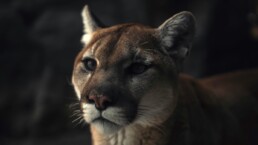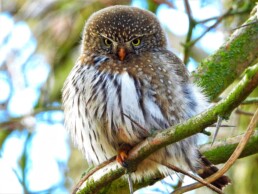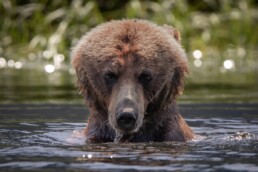They’re called “Great” for a reason. Here’s everything you need to know about the Great Blue Heron, which can be found near the waterways in the city of Castlegar, British Columbia.
The Great Blue Heron is an impressive bird, standing over a metre tall with a wingspan that reaches up to two metres across. These wading birds spend much of their time standing motionless in shallow water, waiting for prey to swim by. Herons can be seen along the shores of the Columbia River year-round and are fascinating to watch as they fish in the shallows.
Also known as:
- Ardea herodias
- wusaq̓ (Ktunaxa)
- te̓llpe7 (Secwepemc)
- skw၎as (nsylixcǝn)
Description:
- A very large wading bird that can stand up to 1.3m tall.
- Great Blue Herons have a blue-grey body and a white head with black stripes above the eyes.
- Adults also have a black crest.
- They have long legs, a long neck, and a big yellow bill.
- They also have a unique flight silhouette with their long neck tucked in an ‘s’ shape, curving onto the back with their long legs trailing out behind.
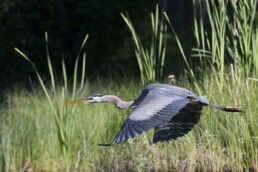
Habitat:
- Great Blue Herons require foraging habitat such as wetlands, ponds, lakes and river banks where they can find abundant small fish and forested nesting habitat nearby.
- They nest in tall trees (20-50m) in quiet woodlands.
- Nests are built of sticks and are usually one metre in diameter.
Viewing Opportunities:
- Look for Great Blue Herons anywhere there is shallow water along the river’s edge or in wetland areas. The best way is to scan the shoreline with binoculars.
- Some great places to watch for them are Zuckerberg Island, Selkirk College, near Waldie Island, or from the waterfront trails at Millennium Park.
- Waldie Island is an important overwintering site for Great Blue Herons, providing shelter from storms on the forested island and shallow, open water for feeding in the winter months. Look for herons here in the fall and winter but remember to give them lots of space and stay off the island itself.
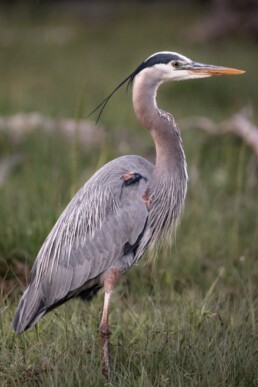
Behaviour:
- Great Blue Herons are patient hunters, standing statue-like in shallow water, waiting for prey to pass and then striking with their long bill.
- Herons are generally quiet, but they do have an impressive repertoire of sounds used during breeding season.
- These large birds are colonial nesters. They will sometimes nest alone, but often nest in colonies of up to 200!
- Some heronries are used for many decades, but often, and in the case of the Waldie Island heronry, they are abandoned after a few years for a new site.
- Herons are seasonally monogamous, staying with the same mate for the breeding season, but finding a new mate every year.
- Heron migration is not consistent across the population. Some herons migrate alone, others migrate in groups of 3-12 or even as many as 100. Some herons don’t migrate at all but overwinter in ice-free bodies of water like the Columbia River.
- They live an average of 15 years, but can live up to 25.
Diet:
- Small fish, crayfish, frogs, salamanders, insects, and occasionally small rodents or birds.
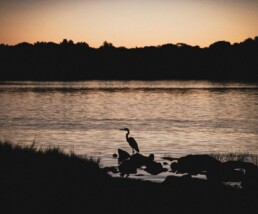
Connections:
- Herons are very sensitive to human presence around nesting sites and will abandon their nests if disturbed at close range.
- In British Columbia, laws limit development within 200-300m of nests.
- Waldie Island is an important overwintering ground for Great Blue Herons. It was acquired by the Nature Trust of BC in 2002 and set aside as a conservation property to protect heron habitat.
Cool Facts:
- Despite their huge appearance, herons only weigh between 2-3kg (4-7 pounds).
- Herons swallow their prey whole. They can digest bones but regurgitate any fur in pellets.
- Aside from coastal populations, most Canadian herons migrate in the winter, but some herons in the Kootenays stay year-round in places where water remains ice free.
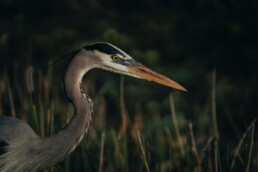
The goal of wildlife viewing is to safely appreciate the animals in their natural surroundings with minimal impact. To achieve that, here are eight tips:
- Be respectful. Getting too close or staying too long can disrupt feeding and other important behaviours and can cause stress and unpredictable behaviour.
- Give wildlife lots of space. If an animal responds to your presence (eg: looks up, watches you, moves away), you are too close.
- Viewing roadside wildlife can have negative impacts on wildlife by disrupting feeding and leading to habituation to traffic and people. If you spot wildlife while driving, pull over only if it is safe to do so and keep your stop short and sweet.
- Keep dogs on leash and under control at all times to avoid negative encounters
- Carry bear spray and know how to use it.
- Use binoculars and zoom lenses.
- Never feed wildlife.
- Leave no trace. Pack it in, pack it out.
Get To Know The Wildlife Of Castlegar
April 3, 2025
Meet Castlegar Photographer Jamie Isaacs
March 1, 2025
Meet Castlegar Photographer Josh Fogal
March 15, 2024


